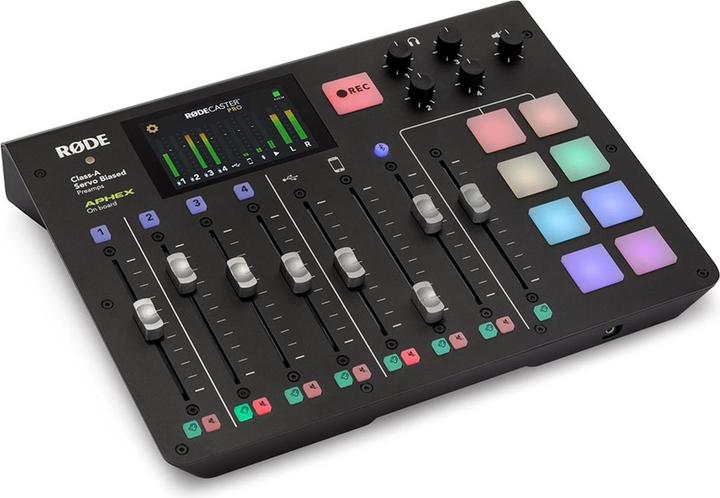

Rode Caster Pro: The ultimate plug-'n'-play solution for podcasters?
Is the Rodecaster Pro the perfect tool for ambitious podcasters? Yes and no.
The podcast wave shows no sign of abating. More and more people are picking up the microphone themselves and starting their own programme. No wonder: in principle, all you need is a microphone and a laptop and you're ready to go. As with most hobbies, however, this is just the beginning. A second and a third microphone are quickly added and suddenly you need an audio interface or a mixing console and so on. The Rodecaster Pro aims to be the plug-'n'-play solution for advanced and over-ambitious hobby podcasters. I belong to the latter group and gave it a try.

I've been making my own gamer podcast for over five years now. My setup now consists of four Rode Procaster microphones and four AKG headphones, which I have connected to a Zoom H6 recording device. I also connect my notebook to the Zoom for the audio recordings. This gives me five separate audio tracks, which I can then mix in the Adobe Audition audio software. The Rodecaster Pro should make this much easier. The features certainly sound promising:
- four XLR microphone connections
- four 6.3 mm headphone inputs with individual volume control
- Recording to micro SD card
- Eight programmable audio buttons
- Connectivity via 3.5 mm, Bluetooth and USB-C
- Integrated audio processing
The setup is largely self-explanatory. If you do have a question, Rode has included four huge cardboard cards that explain the most important functions. Firstly, you should connect the Rodecaster to the PC via USB and carry out a firmware update using the appertaining software. Rode is constantly releasing updates. Several of my points of criticism, such as the lack of multitrack, have already been eliminated in the course of this test.
Multiple recording options
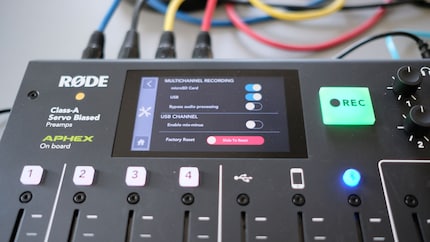
The simplest recording option is via microSD card. Connect microphones and headphones, press the green REC button and the device will record. Alternatively, you can connect the device to your notebook using a USB-C cable. To ensure that all 14 (!) audio sources are recognised correctly and can be mixed individually on the PC, you must follow the instructions very carefully. You can currently find walkthroughs for Audition, Garageband, Logic Pro X, ProTools and Reaper.
Since version 1.2, the Rodecaster supports multitrack both via USB and microSD. This allows you to save all audio tracks individually without using a laptop. Multitrack is extremely practical if you only want to edit one track. If you are only working with one audio track, Rodecaster can also mix everything together. In both cases, you only receive a single WAV file for editing. The first time I used it, I found it a bit complicated to pick out the five tracks (four voices and one music track) I needed from 14 tracks.
Connections en masse
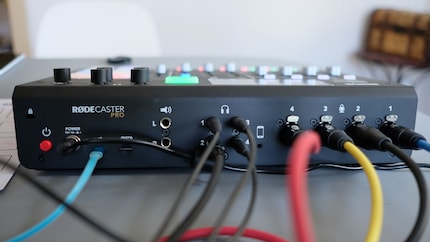
In addition to the four XLR microphones, you can connect other devices via USB, Bluetooth or 3.5 mm plug. Pairing via Bluetooth worked straight away. Unfortunately, the connection is very delayed. If you want to use the smartphone as a soundboard, as I did, it takes several seconds before the sound can be heard on the Rodecaster. The joke is usually over by then - or it only becomes really funny because of the delay. It all depends on your audience. It worked better with the 3.5 mm plug. The disadvantage is that you need another cable. You can mute each source at the touch of a button or listen to it individually via the master audio output.
I've also connected my laptop via USB-C to connect a guest via Discord or to control a soundboard. The microphone and headphones were still connected to the Rodecaster. This way, my dialogue partner could even hear my recordings. Thanks to the mix-minus function for USB, you don't have to worry about your conversation partner hearing their own echo. Rodcaster's connection options are really versatile and easy to use.
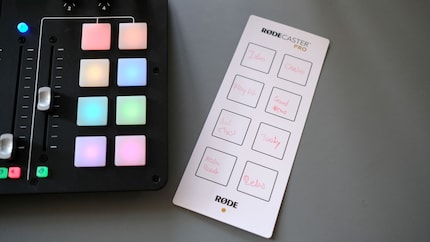
I'm still not completely convinced by the eight programmable buttons. They have pre-installed sound effects. These can either be overwritten with a local recording or via the PC app. The Rodecaster has 512 MB of internal memory, which should be enough for most files. Unfortunately, the buttons cannot be assigned twice and you have to keep track of which button does what. As soon as the recording is running, you can no longer check this in the menu. At least you can choose the colour yourself. Rode has included a few cards that you can label. You have to edit your sound files before uploading them. The Rodecaster can only play the files.
Almost all audio effects are convincing
One of the most important selling points of the Rodecaster is the integrated audio editing. You can access the audio settings via the touchscreen or by pressing the respective number button for the microphone. There are profiles for strong, weak, low or high voices. The easiest thing to do is to try out what suits which speaker best. You will hear quite quickly if someone with a high voice is linked to settings for a low pitch. During the recording, you can also set brands at the touch of a button so that you can find certain parts again when editing.
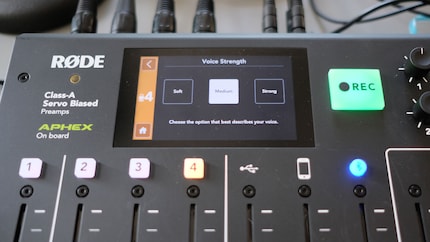
The sound effects are a question of taste. You can choose from a noise gate, compressor, de-esser, ducking and high pass filter. This allows you to automatically make voices stronger, remove sibilance or minimise background noise. Ducking is only available on channel 1 and automatically lowers the other three microphones as soon as the host speaks. With Aphex Aural Exciter and Big Bottom, you also get two effects that come from the professional audio sector and should also make the podcast sound better.
Until now, I have mostly worked without audio effects as I was never able to achieve a satisfactory result. It simply sounded best unfiltered. This certainly has something to do with the fact that I'm not an expert in audio processing. Rode now wants to help people like me. And I have to say, I like what I hear. After a bit of trial and error, I left all the effects activated except for Noise Gate. This makes our podcast sound a bit more like a studio recording. The voices are stronger and the slight reverb has disappeared. But don't expect miracles. You can still achieve the greatest effect with good microphones and a quiet environment.
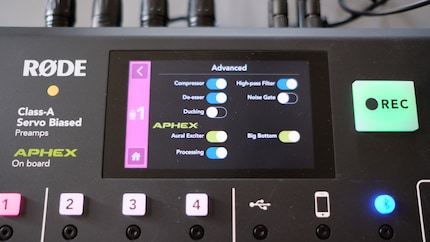
I didn't use Noise Gate because the effect works uncleanly. Noise Gate is supposed to filter out noise. However, the effect is so strong that the voice is suddenly cut off if you move too far away from the microphone. Unfortunately, the effects can only be switched on and off, but not fine-tuned. However, in the recording options, you can specify separately and across all audio inputs whether you want to work with or without audio effects.
The first time I tried the Rodecaster, there were two small sound dropouts. You can hear it in the intro of our podcast at second 10 and again in the outro at 1:01:20. I didn't notice any more glitches in the next two recordings. It is not clear from the patch logs whether the firmware updates have fixed this. All episodes from 103 onwards are recorded with the Rodecaster. If you want to get an idea of how the sound has changed with it, just listen to an older recording.
You still need your notebook
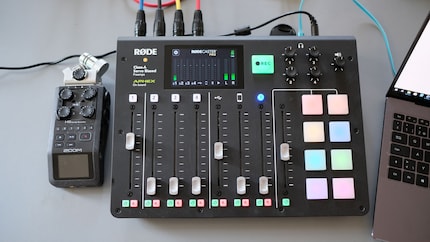
Another advantage over my setup is that I can finally connect all the headphones individually and control the volume individually. Previously, I used a multiple coupling, as the Zoom only has one headphone connection. With the Rodecaster, every podcaster can now choose how loud he or she likes it. What I don't understand is why the master headphone output on the front doesn't have its own volume control.
The Rodecaster's preamp also has more power than the Zoom H6. This means that my Procaster microphones are finally no longer running at the limit. I have to turn the gain up almost to the maximum to make our voices loud enough. I always run the risk of noise or the microphones picking up each other, which leads to annoying reverberation. The class A preamps from the Rodecaster definitely do a better job here.
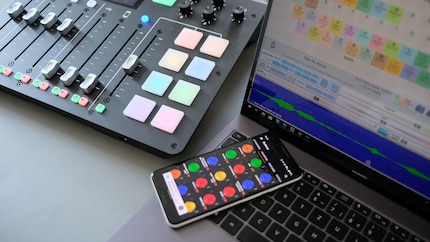
I can only do without my notebook to a limited extent when recording. If I really want to use all the audio inputs, the eight buttons on the Rodecaster are not enough for me. The free software Soundplant is still more reliable. In the meantime, I've also tried Instant Buttons on my smartphone. However, I'm not as fast with these as I am with Soundplant and if I want to read my notes at the same time, I'm best off using my notebook.
But even if you work without a player, you still need a computer. Because the Rodecaster doesn't cut your recording. Unless you have perfect timing when switching on and off, you can't avoid cutting out the beginning and end in an audio programme. Your podcast host may also require an MP3 file.
Conclusion: Too expensive for beginners, incomplete for professionals
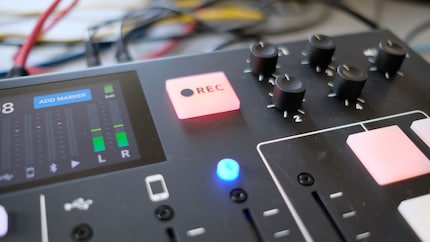
The Rodecaster is not easy to categorise. On the one hand, it is extremely versatile thanks to the numerous connection options such as Bluetooth or the four XLR microphones. Each source can be mixed separately, all podcasters determine their own volume and the eight sound buttons are sufficient as a small soundboard. The integrated audio effects also impressed someone like me who knows little about mixing. Thanks to the choice between multitrack or a single track, both beginners and experienced podcasters are well served.
On the other hand, the Rodecaster is actually too expensive for hobby podcasters like me. After all, I also need to be able to afford microphones, stands and headphones. For medium-sized or professional podcasters, on the other hand, the Rodecaster seems too limited. If you know your trade, you either want to edit the sound yourself on the computer or at least be able to fine-tune the available effects. And if you're recording on a laptop anyway, a mixing console will suffice.
As a child, I wasn't allowed to have any consoles. It was only with the arrival of the family's 486 PC that the magical world of gaming opened up to me. Today, I'm overcompensating accordingly. Only a lack of time and money prevents me from trying out every game there is and decorating my shelf with rare retro consoles.
These articles might also interest you

Product test
CMF Headphone Pro tested: Good over-ear headphones for little money
by Jan Johannsen
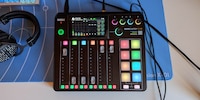
Product test
Testing the Rodecaster Pro II Audio studio: more versatile and extensive, but lacking some polish
by Philipp Rüegg

Product test
Nothing Ear (3) tested: better phone calls with a microphone in the case
by Jan Johannsen


